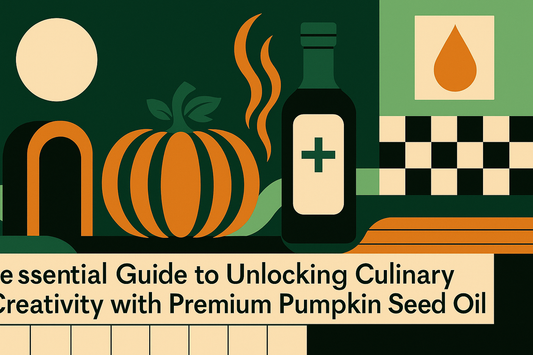
How Toasting Transforms Pumpkin Seed Oil's Flavor and Health Benefits
Introduction
Pumpkin seed oil has firmly established itself as a cherished natural ingredient in many kitchens. Its unique flavor profile and appealing aroma have helped it gain popularity among those who appreciate natural, high-quality oils. At the heart of its appeal is the special process used to create it. Unlike some methods that rely solely on cold extraction, the method of gently toasting the seeds plays a key role in both enriching the flavor and preserving essential nutrients. This guide explores how toasting transforms the oil into a rich, flavorful, and nutrient-enhanced product.
The Toasting Process Explained
What is the Toasting Process?
The toasting process involves lightly roasting pumpkin seeds before the oil is extracted. This step is carried out with precision and care to bring out the seeds' natural characteristics. The gentle heat treatment not only intensifies the nutty notes inherent in the seeds but also helps lock in vital components. This process differs markedly from some cold extraction methods, leading to a distinctly robust and aromatic oil.
Traditional Methods vs Modern Techniques
Historically, producers have used a method based on the traditional pumpkin seed oil production method, where seeds were roasted over controlled heat to enhance their natural flavor. Over time, modern techniques have evolved to ensure consistency in quality. Today, many producers favor the non cold-pressed approach, which offers significant advantages by emphasizing flavor enhancement through toasting rather than relying on a purely cold extraction. This careful balancing of tradition and modernity has resulted in a product that delivers both deep flavor and preserved nutrient content.
Impact on Flavor and Aroma
Developing a Rich, Nutty Profile
The true magic of toasting lies in its ability to unlock a rich, nutty flavor profile. As the seeds are carefully roasted, the natural oils become infused with deep, aromatic notes. This transformation results in a warm, inviting oil that boasts a deep green color and a bouquet that hints at roasted nuts and earthiness. It is through this process that one can truly appreciate how toasted processing improves pumpkin seed oil flavor, making it a standout ingredient in the kitchen.
Sensory Benefits for Culinary Uses
The enhanced flavor and aroma achieved through toasting significantly elevate the culinary experience. When used as a finishing oil, balanced drizzles of toasted pumpkin seed oil can add a delightful twist to salads, vegetables, and even hearty grain bowls. This oil contributes not only a burst of flavor but also an inviting aroma that can transform an ordinary dish into something special. The rich taste profile makes it a practical addition to your pantry if you enjoy experimenting with natural ingredients to enhance everyday recipes.
Nutritional Benefits Enhanced by Toasting
Nutrient Preservation and Enhancement
The process of toasting is not only about flavor; it also plays a significant role in preserving and in some cases, enhancing the nutrient content of pumpkin seed oil. Key nutrients such as Vitamin E, zinc, and essential omega fatty acids are carefully maintained through the controlled use of heat. Many enthusiasts have observed that the gentle roasting does not cause the degradation of these beneficial elements. Instead, it preserves their natural goodness, contributing to an oil that is as nourishing as it is flavorful.
Supporting Wellness Naturally
An improved nutrient profile adds an extra layer of appeal, linking this oil to everyday wellness practices. While maintaining a balanced diet is always important, incorporating a natural oil that has undergone a thoughtful toasting process can complement healthy habits. The benefits of pumpkin seed oil are enhanced by its rich composition, supporting wellness naturally when included as part of a varied diet.
Sourcing and Sustainability
From Local Farms to Processing Facilities
The journey of pumpkin seed oil begins long before it reaches your table. High-quality pumpkin seeds are sourced with great care from reputable farmlands in the Styrian region. This careful approach ensures that every batch of oil meets strict quality standards. Sustainable practices are central to the process, with attention paid to environmental impact and resource conservation. By emphasizing quality control and responsible sourcing, producers create an oil that truly reflects its natural origins.
Practical Uses in the Kitchen
Incorporation Tips
Integrating toasted pumpkin seed oil into everyday cooking is both simple and rewarding. Because the flavor is so pronounced, the oil is best used as a finishing touch. A light drizzle over a fresh salad or a completed dish can enhance flavors without overpowering the natural tastes of the ingredients. It can also be easily blended into dressings or even stirred into dips, providing an extra layer of flavor that many home cooks appreciate and enjoy.
Pairing Ideas
This oil pairs beautifully with a range of dishes. Its nutty profile complements mixed greens, roasted vegetables, and hearty grains beautifully. For instance, a dish featuring lightly steamed greens and a sprinkle of toasted pumpkin seed oil can transform even the simplest ingredients into a refined culinary experience. It also works well in recipes where a deep, natural flavor is desired. Experimenting with this oil can open up new possibilities in the kitchen, allowing each meal to become a celebration of natural, bold taste.
Conclusion
In summary, the toasting process stands out as a crucial step in creating pumpkin seed oil that is both flavorful and nourishing. By gently roasting the seeds prior to extraction, the process imbues the oil with a rich, nutty aroma and helps preserve important nutrients. As explored throughout this guide, understanding how the production method influences quality can enhance both cooking and overall wellness. For those seeking the distinctive benefits and robust flavor profile of toasted pumpkin seed oil, choosing products that honor this traditional yet refined process can make all the difference. Consider exploring further resources or collections that celebrate natural oil processing techniques, and experience first-hand the unique character of a well-crafted oil.
FAQs
Q: What differentiates toasted pumpkin seed oil from cold pressed versions?
A: Toasting involves gently roasting the seeds before pressing, which develops a richer, nutty flavor while preserving key nutrients.
Q: Does the toasting process compromise the oil's nutrient profile?
A: When the process is carefully managed, toasting can maintain and even enhance the beneficial nutrients found in the oil.
Q: How can I incorporate toasted pumpkin seed oil into my cooking routine?
A: It is best used as a finishing oil for salads, drizzled over dishes, or mixed into dressings to add a robust flavor twist.



